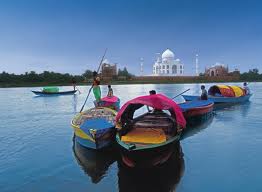The beautiful city is situated on the banks of holy river Yamuna. Agra is the third largest city in the state of Utter Pradesh in India and a prominent tourist destination in the country. Millions of tourists visit Agra from all across the world every year to see the beauty of majestic Taj Mahal and other historical monument lying every where in the city. Agra is primarily witness of Mughal architectural excellence and their love for structural designs. Agra is also a prime center of rich cultural heritage and art in India. No trip to Indiacan be considered as complete without visiting to Agra.
Location of Agra
Agra(lon-21.133744 lat-81.886168) is situated on the bank of river Yamuna, it is the third biggest municipality of the state Utter Pradesh inIndia.Agrais only 200 kilometer away form the capital of the country,New Delhi.Agrais surrounded by few major cities likeMathura, Bharatpur, Firizabad and Fatehabad
History of Agra
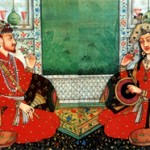 Agrawas founded by Lord Krishna’s motherly grandfather Agrasen, and therefore it comes to be recognized as Agra. Ptolemy, the Greek geographer, scheduled it in the second century A. D. basically as Agraon his map of the earth. Realizing its business and deliberate significance, Sikandar Lodi of the Afgan family made it the capital of his empire. His son Ibrahim Lodi was a weak and the town was captured by Babar in 1526.
Agrawas founded by Lord Krishna’s motherly grandfather Agrasen, and therefore it comes to be recognized as Agra. Ptolemy, the Greek geographer, scheduled it in the second century A. D. basically as Agraon his map of the earth. Realizing its business and deliberate significance, Sikandar Lodi of the Afgan family made it the capital of his empire. His son Ibrahim Lodi was a weak and the town was captured by Babar in 1526.
The well-known Kohinoor diamond knock down into his hands as a part of plunder. In 1539 and 1540, Sher Shah, the revolutionary Afgan scared Humayun, the son of Babar, in two important battle and become the leader of Delhi and Agra. It was then the foundation of immense G. T. Road through Agra was laid down. Monarch Akbar re-established Mughal rule over Agra and big parts of north India between 1556 and1605.
Even though Babar and Humayun were accountable for early Mughal structural design, it was Akbar that Agra grows to immense height. An able superintendent and a big fan of beauty. Akbar builds the huge Red Fort of Agra and a new capital, Fatehpur Sikri. Akbar stayed in Agra until 1570, and then shifted to his new capital Fatehpur Sikri, stayed there until 1585 then shifted to Lahore but return to Agra in 1599 and stayed there till his death in 1605, he was covered at Sikandra.
Thirty six year later on Jahangir, the child of Akbar came to throne. Mughal glory, the base of which was laid down by Akbar, reached its height under Shah Jahan, child of Jahangir, who came to throne in 1627 and ruled to thirty years.
ShahJahan’s love for beauty can be seen in his monument of everlasting love, the Taj Mahal, built in remembrance of his beloved wife Mumtaj Mahal.Agrahas been forefront of the liberty struggle as a center for most important political actions. The Indian innovatory Bhagat Singh did significantly underground work here and the Kakori revolt was also designed here.
Places to Visit
Taj Mahal
Agra hosts the most beautiful wonder of the world the great Taj Mahal. Standing with grandeur and elegance on the Banks of River Yamuna, Taj Mahal is an eternal tribute to one of the greatest love stories ever. Built by Shahjahan for his wife Mumtaz Mahal, this white wonder of the architectural world is situated in the city of Agrain Uttar Pradesh state. The real beauty of Taj Mahal is that it exhibits different facets during different times of the day. Take a look at it with the rising sun and it will set a completely different mood than what it did when you saw it under the full moon light.
Taj Mahal is one of the most admired and cared for monument in the world. It was recognized as World Heritage Site by UNESCO in 1983. It was also chosen among the Seven Wonder of the World. Recently, it again made headlines when it retained its position among the new Seven Wonders of the World. This is a mausoleum of the King Shah Jahan’s beloved wife Mumtaj Mahal. The construction of Taj Mahal was begun in 1630 and took 23 years to complete in the year 1653. Made up of white marble. Now after three centuries since its construction, Taj Mahal has been seen by millions of people from all across the globe and it is still the most attractive monument in the world.
Red Fort Agra
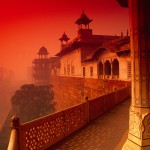 The Red Fort Agra is also located on the other side of the river Yamuna and the top of the Fort presents a beautiful view of Taj Mahal. The Red Fort was constructed by the great Mughal King Akbar between 1565 and 1574 but most of the beautification work was done by his son Shah Jahan. Today a major part of the Fort is occupied by the armed forces and is closed for public. Etmad-Ud-Daulah and Sikandra are other two important sites to be visited inAgra.
The Red Fort Agra is also located on the other side of the river Yamuna and the top of the Fort presents a beautiful view of Taj Mahal. The Red Fort was constructed by the great Mughal King Akbar between 1565 and 1574 but most of the beautification work was done by his son Shah Jahan. Today a major part of the Fort is occupied by the armed forces and is closed for public. Etmad-Ud-Daulah and Sikandra are other two important sites to be visited inAgra.
Fatehpur Sikri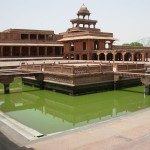
Fatehpur Sikri is a fascinating ghost city built in the 16th century, 37 km fromAgra. Fatehpur Sikri is the imperial city of the Mughal dynasty. It is very difficult to express the architectural grandeur of this city as one can only experience the aura of these forts. Famously known as the city ofGhosts, it was built by the Great Mughal Emperor. Fatehpur Sikri is a place worth visiting to discover how once the city could have been which has now turned into ruins This historic site was founded by Akbar the great, who at 26 years did not have a heir. He went to a saint, Shaikh Salim Chishti who lived in a city called Sikri. His blessing gave Akbar 3 sons. As a gesture, Akbar built a wholenew cityin Sikri.
The buildings at Fatehpur Sikri blended both Islamic and Hindu elements in their architectural style.
It was built between 1569 and 1585 and was intended to be the joint capital withAgra, but was soon deserted because the water system could not support any residents. It remained untouched for over 400 years now and its palaces are a remainder of the extravagance of the Mughals. The places one can see at Fatehpur Sikri are –The Buland Gate, Darga Salim Chishti,Panch Mahal, Diwan-E-Khas
Etmad-Ud-Daulah
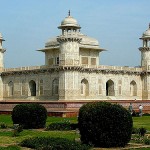 Often referred to as the ‘Jewel Box’, the Itmad-Ud-Daulah’s Tomb is a Mughal mausoleum located at the city of Agrain Uttar Pradesh state of Indiaand is treated as one of the major tourist attractions there. It is sometimes also described as a ‘draft’ of the exquisite Taj Mahal because of its resemblance to the latter.
Often referred to as the ‘Jewel Box’, the Itmad-Ud-Daulah’s Tomb is a Mughal mausoleum located at the city of Agrain Uttar Pradesh state of Indiaand is treated as one of the major tourist attractions there. It is sometimes also described as a ‘draft’ of the exquisite Taj Mahal because of its resemblance to the latter.
Built in between 1622 and 1628, the Tomb of Itmad Ud Daulah at Agra was commissioned by the wife of Emperor Jehangir, Nur Jahan for her father Mirza Ghiyas Beg, who had been given bestowed with the title of Itimâd-ud-Daulâ meaning the pillar of the state. Apart from the central building, the Itmad Ud Daulah Mausoleum of Agra comprises various other outer buildings as well and gardens.
The tomb construction captures the gradual shift from the primary phase of classic Mughal architecture built mainly of red sandstone with marble inlay work (example – Humayun’s Tomb) to the next phase highlighting ample use of white marble and pietra dura inlay (example – Taj Mahal). Perched on the left bank of the holy river Yamuna, the Itmad Ud Daulah is based on a huge cruciform garden zigzagged by waterways and walking lanes.
Itmad Ud Daulah has walls made out of gleaming white marble imported from the neighboring Rajasthan state and are artistically encrusted with semi-precious stone embellishments like cornelian, jasper, lapis lazuli, onyx, and topaz in the motifs of cypress trees and wine bottles. Light gains access to the interiors of the tomb through the intricately carved net screens made out of white marble. Many relatives of Nur Jahan are interred in this Itmad Ud Daulah Mausoleum atAgra
Sikandra Fort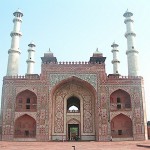
Sikandra is another example of the majestic Mughal art. The construction of the monument was initiated by the mighty Mughal emperor Akbar but was completed by his son Jehangir. The monument hence, is the mausoleum of Akbar. Akbar’s tomb is located in the serene ambience of Sikandra 3 km away fromAgra. Some of its design features are similar to the design of the Taj Mahal built later inAgra. Akbar’s tomb at Sikandra has a large arched entrance and green lawns, on which deer can be seen grazing, surround the tomb. The entrance is decorated with marble inlay work around the arch, and the inner surface of the dome of the tomb is decorated with images of flowers, geometric designs and Islamic calligraphy.
Culture of Agra
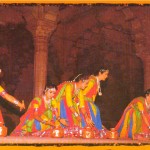 Agrais influenced by Brij culture which is influenced by the tales of Lord Krishna. Modern day Agrawas founded by Sikander Lodi of Lodidynasty which ruled Delhiduring 16th century. Later it was captured by Moguls. During the times of Moguls, Agrabecame an important city. Cityscape of Agrawas designed by the Moguls according to the Mogul architectural designs. There are many historical monuments belonging to Mogul era. Mogul architecture was the mix of Indian and Islamic architecture. Agrawas also ruled by Rajput rulers before Moguls and Lodi. They also left their legacy in the form of the culture and monuments.
Agrais influenced by Brij culture which is influenced by the tales of Lord Krishna. Modern day Agrawas founded by Sikander Lodi of Lodidynasty which ruled Delhiduring 16th century. Later it was captured by Moguls. During the times of Moguls, Agrabecame an important city. Cityscape of Agrawas designed by the Moguls according to the Mogul architectural designs. There are many historical monuments belonging to Mogul era. Mogul architecture was the mix of Indian and Islamic architecture. Agrawas also ruled by Rajput rulers before Moguls and Lodi. They also left their legacy in the form of the culture and monuments.
Culture ofAgra is very rich and unique in its own sense like any other historical city.Agra is the most famous tourist destination inIndia. It hosts millions of international as well national tourists every year. Besides the natives,Agra faces many foreigners also. This creates a different and unique culture forAgra.
One of the important aspects of the culture ofAgrais the variety of colourful festivals. During the month of February, the city witnesses the Taj Mahotsav. Held in Shilpgram that is quite close to the Taj Mahal, the ten-day long festival hosts an exhibition of the crafts, arts, classical song and dance performances. Camel and elephant rides are worth an experience. Id, the festival of the Islamic is celebrated with great pomp. The main languages inAgraare Hindi and Urdu. The city is famous for Mughlai dishes and typicalAgradelicacies.
How to reach Agra?
Agra is connected to Delhi and neighboring cities by air, rail and road.
By Air: It is only 30 minutes’ hop fromDelhi. The ‘Kheria’ airport is only 6km away from the city center. National and other private airlines connectsAgra toDelhi, Khajuraho andVaranasi. Taxis and autorikshas are available in large numbers at the airport.
By Rail: Agrais a major railway junction on main broad guage routes to the south, east and west.Agra’s railway station is Agra Cantonment. There are excellent train services fromNew Delhi. Shatabdi Express, Taj Express and Inter-city Express fromDelhitakes 2-3 hours to reachAgra. Some other train servicing the city are : G.T. Express (New Delhito Chennai), Dadar Express (Mumbai toAmritsar), Jhelum Express (Jammuto Pune), Kalinga Utkal Express (New Delhito Puri), Karnataka Express (New Delhito Trivendrum), Ujjani Express (Dehradoon toUjjain) and Hyderabad Express (New DelhitoHyderabad).
By Road: Agrais on the cross roads of national highways 2, 3 and 11 and is well connected to all parts of the country. ‘Idgah’ is the main bus terminal inAgra. Most of the buses leaveAgrafrom here. Express and air-conditioned bus services are available fromDelhi, Jaipur,Lucknow, Gualior andJhansi. Buses are less expensive in comparison with train and air services. Rest houses and catering facilities are available en-route of journey.
Basic Facts about Agra
| Location : | Uttar Pradesh State,India. |
| Distance from National Capital : | 200 kms approx. |
| Estimated population: | 1.4 millions. |
| Altitude: | 169 Meters above sea level |
| Area: | 4082 sq. km. |
| Winter: | 4.20 C 31.70 C |
| Language: | Hindi, Urdu, English |
| Temperature: | Summer – 21.90 °C – 45.00 °C |
| Rainfall: | Average yearly 66 cm. |
| Clothes:Summer Winter |
Cotton Light Woolens |
| Country Code (India): | 0091 |
| STD code: | 0562 |
Agra Photo Gallery
Submit your review | |
